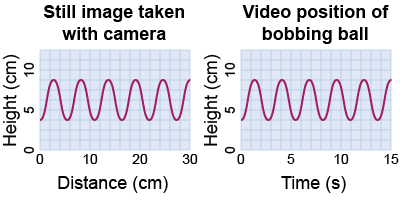 Blue whales are able to communicate over very large distances using low-frequency sound waves. Their communication range is limited by background noise from shipping and by absorption. When a wave is absorbed, what wave property changes? Blue whales are able to communicate over very large distances using low-frequency sound waves. Their communication range is limited by background noise from shipping and by absorption. When a wave is absorbed, what wave property changes? - wave velocity
- wavelength
- amplitude
- frequency
- Light refracts as it passes the boundary between air and glass in a camera lens. Which of these wave properties change when the wave refracts, and which remain the same?
- wave speed
- frequency
- wavelength
- direction
 When you are conducting an investigation using a ripple tank and a wave reflects off a surface with the same amplitude, where does its energy go? When you are conducting an investigation using a ripple tank and a wave reflects off a surface with the same amplitude, where does its energy go?
 When a light wave refracts through a glass lens, where does its energy go? When a light wave refracts through a glass lens, where does its energy go?
 When a wave passes through a hole and undergoes diffraction on the other side, where does its energy go? When a wave passes through a hole and undergoes diffraction on the other side, where does its energy go?
 When a light wave is partially absorbed by passing through a glass window, where does its energy go? When a light wave is partially absorbed by passing through a glass window, where does its energy go?
 If you want to make a light source brighter, would you use constructive or destructive interference? If you want to make a light source brighter, would you use constructive or destructive interference?
- Your assignment is to stretch an elastic band on which you will create a standing wave. Why is it better to mount the elastic band with a ring stand and clamps than to have your partner hold it between her hands?
 Draw two waves with the same wavelength and amplitude that will interfere constructively and two that will interfere destructively. Draw two waves with the same wavelength and amplitude that will interfere constructively and two that will interfere destructively.
 A standing wave in a stretched string of length L is vibrating at its fundamental frequency f. The length of the string is doubled, and it is again caused to vibrate at its fundamental frequency. What is the new wavelength? What is the new fundamental frequency? A standing wave in a stretched string of length L is vibrating at its fundamental frequency f. The length of the string is doubled, and it is again caused to vibrate at its fundamental frequency. What is the new wavelength? What is the new fundamental frequency?
| |
- Shazi was using a ripple tank and stopwatch. She timed 4.0 s as the time it took for 10 wave crests to pass a certain location in the tank.
- What is the period of the waves from her data? Use the correct number of significant figures in your answer.
- What is the frequency of the waves?
 How far does a wave travel during a time span corresponding to five periods of the wave’s oscillation? How far does a wave travel during a time span corresponding to five periods of the wave’s oscillation?
 Two waves are traveling at the same speed in the same medium. Wave A has twice the wavelength of wave B. Which wave has a longer period? Two waves are traveling at the same speed in the same medium. Wave A has twice the wavelength of wave B. Which wave has a longer period?
 A water wave has a wavelength of 204 m and a frequency of 0.5 Hz. How far does it travel in 1 s? A water wave has a wavelength of 204 m and a frequency of 0.5 Hz. How far does it travel in 1 s?

 A student was conducting an investigation with water waves in a large wave tank. He took a still image with a digital camera (shown above left) to measure the water position at an instant in time. He also took a video of a ball bobbing up and down in the water (shown above right). A student was conducting an investigation with water waves in a large wave tank. He took a still image with a digital camera (shown above left) to measure the water position at an instant in time. He also took a video of a ball bobbing up and down in the water (shown above right).
- What is the amplitude of the waves?
- What is the wavelength of the waves?
- What is the frequency of the waves?
- What is the velocity of the waves?
- Infrasound is sound that is too low a frequency for our ears to detect. These sounds may cause nausea or feelings of discomfort. What is the wavelength of an inaudible 15 Hz infrasonic sound wave? The speed of sound in air is 343 m/s.
- Sound speed in the ocean increases with depth. A submarine close to the surface, where the speed of sound is 1,480 m/s, produces a 10 kHz sound that is detected by a sonobuoy at a depth of 5.0 km, where the sound speed is 1,540 m/s.
- As sound speed increases, does the wavelength increase or decrease?
- What is the change in the wavelength of the sound between these two points?
|

